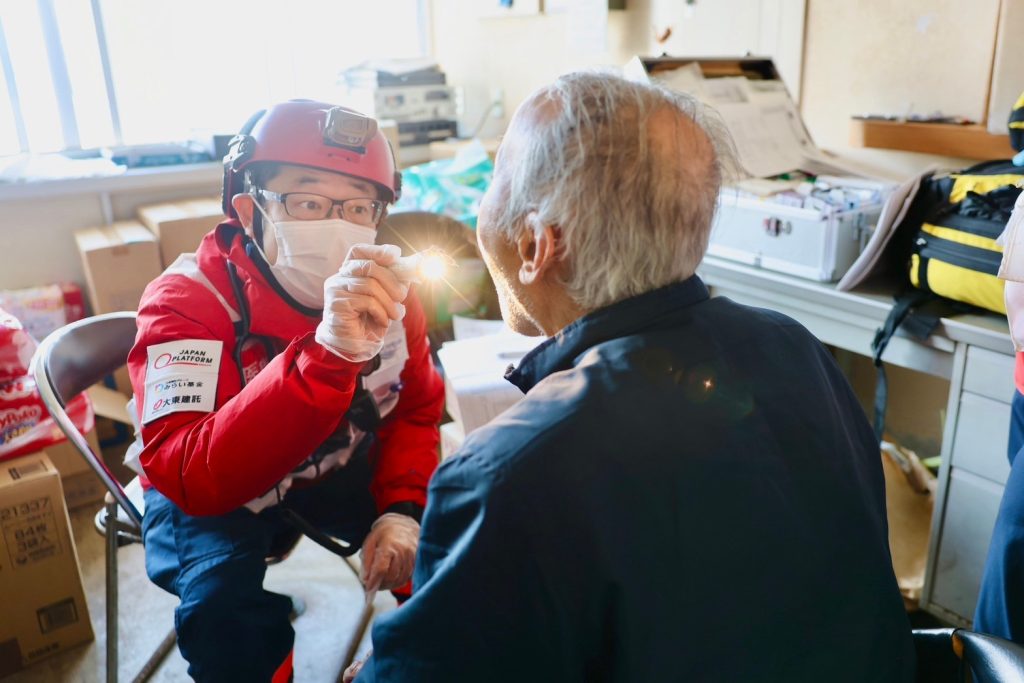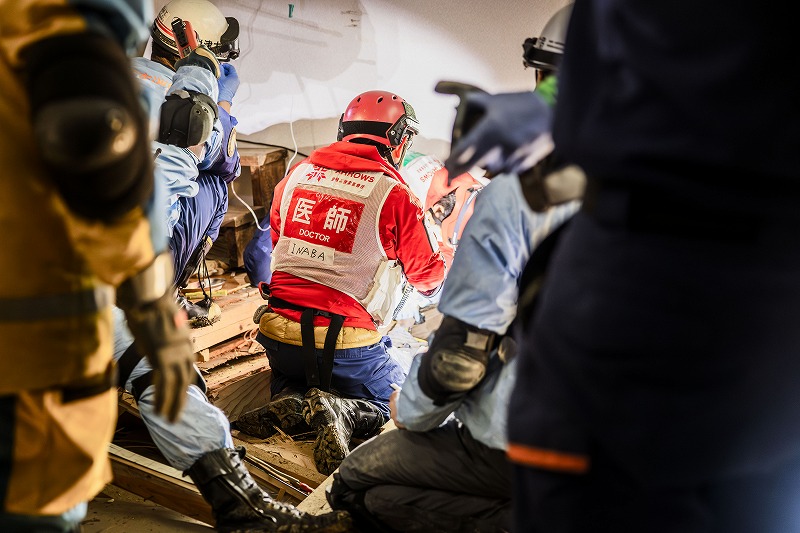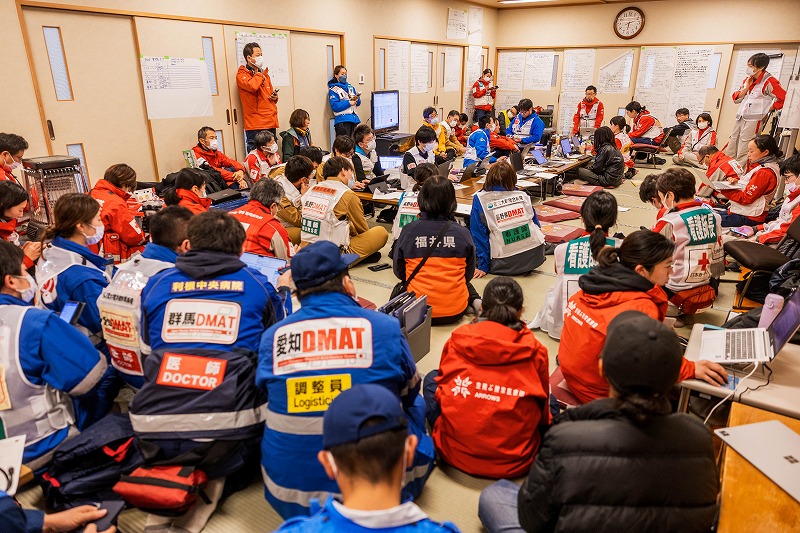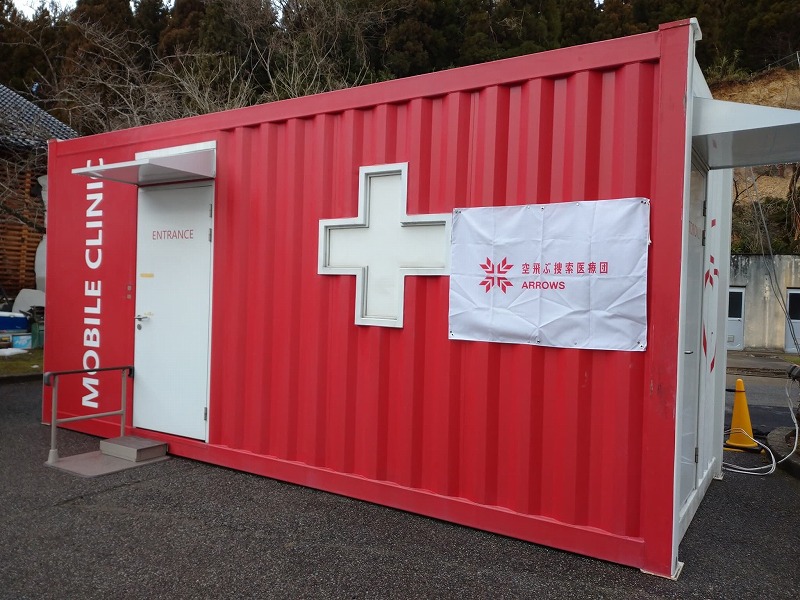Ongoing Support for Ishikawa Earthquake Survivors: An Interview with ARROWS Dr. Inaba
More than one month after the New Year’s Day earthquake in Japan’s Noto Peninsula, Peace Winds teams remain on the ground aiding survivors in and around Suzu City, Ishikawa Prefecture. Approximately 1,400 people here are still displaced from their homes, and nearly 5,000 families do not have running water.
Peace Winds continues to support evacuation center operations, distribution of essential supplies, and medical care alongside the local government and partner organizations. Last week, our teams completed the setup of a new temporary shelter in a local elementary school, and the first families have begun to move in.
As the situation stabilizes, an emerging need for evacuees living in temporary shelters is household items such as hot plates and microwaves. Peace Winds distributed a number of these items to families in evacuation centers last week and will continue to do so over the coming weeks. Amid the cold winter weather, our staff have also continued distributing oil for heating and cooking.
Medical care remains an important part of relief and recovery efforts in Suzu City as the number of survivors seeking treatment remains steady. Over the last month, Peace Winds’ doctors and nurses have treated more than 300 patients in mobile clinics established at five evacuation centers in the area. One of these doctors is Dr. Mototaka Inaba.
Dr. Inaba is a member of Peace Winds’ airborne emergency response team, ARROWS, and he and his teammates jumped into action to rescue survivors almost immediately after the earthquake. Alongside his colleagues, NGO partners, and the local government, he has played an instrumental role in relief efforts over the past month. We spoke to him about his reflections on the disaster and the response, including the lessons he and the team have learned when it comes to saving lives.
One month has passed since the New Year’s Day Noto Peninsula Earthquake. How do you feel about what you’ve accomplished up to this point?
Dr. Inaba: When the earthquake struck, I was relaxing at home for the first time in a while after celebrating the New Year. My child saw the news report on TV and ran into my room, so I rushed to the TV and learned that the entire Noto Peninsula had been hit by a major earthquake. I was praying that the destruction wouldn’t be too bad, but then I saw a video of a house I recognized collapsing in Suzu City. I immediately rushed to the ARROWS headquarters (Peace Winds’ airborne search and medical team) in Jinsekikogen, Hiroshima. I set out with other members of our team, and we arrived in Suzu City on the morning of January 2 to begin our aid activities.
When I look back on the past month, the first thing that comes to mind is how many people couldn’t be saved and how many lives were lost. I pray that their souls rest in peace. But I believe that ARROWS did the best we could under such difficult circumstances. It was my first time experiencing a disaster like this, so I’ve learned a lot over the past month.
One of these is Confined Space Rescue Medicine (CSRM), a special skill for treating and rescuing people in confined spaces such as collapsed homes.
Dr. Inaba: Yes. In the first phase of medical care during a disaster, the main focus is on rescuing and treating people who are trapped in collapsed homes. Unfortunately, there were many cases where we had to pronounce the victims dead. But we were able to rescue an elderly woman who was buried under the rubble for 124 hours, even though it is typically said that there is a 72-hour window for saving people in situations like this. Despite the harsh conditions in the middle of a snow storm, it was truly an honor to work alongside local rescuers, provide the best medical care, and save this woman’s life.
What kind of difficulties did you face in responding to this disaster?
Dr. Inaba: There are two main elements. One is that Suzu City has a large population of elderly people. The second challenge is due to the geographical location because the earthquake occurred at the northern tip of the peninsula, known as “Oku-Noto.”
The combination of power outages, water outages, and cold weather made conditions especially difficult for the elderly. While working to save lives of those in need of immediate care, there is also the urgent need to transport people who require special care, emergency surgery, or are critically ill to urban hospitals. However, some roads were cut off due to landslides and ground upheavals, making ground transportation nearly impossible. Even if we wanted to transport a patient, ambulances couldn’t get through. This problem persisted for a while and made our response particularly challenging.
Your team made great use of helicopters for transporting patients.
Dr. Inaba: Right, ARROWS deployed two helicopters to Noto on January 2 to help transport patients, but we were able to carry this out in collaboration with medical helicopters and the Japan Self-Defense Forces (JSDF). I think that was really important.
In previous disaster relief efforts, ARROWS, medical helicopters, and JSDF transported patients within their respective command lines. But this time, the three organizations collaborated at the request of Ishikawa Prefecture’s local government. By taking advantage of each group’s strengths, we were able to divide the tasks and transport patients efficiently. In fact, this is the first time in history that the public and private sectors have collaborated to airlift patients during a disaster.
What made it possible to collaborate between organizations with different chains of command?
Dr. Inaba: I believe this is the result of joint training between us, a private NGO, the Cabinet Office, and the Ministry of Health, Labour and Welfare’s Disaster Medical Assistance Team (DMAT). Our past experience in disaster relief helped a lot. We have held a number of discussions about how this kind of collaboration is essential for helping as many people as possible in large-scale disasters. I’m really glad we were able to use the knowledge we gained in government training to save lives.
When it comes to disaster medicine, there is often an issue of “disaster-related death.” What measures did you take to address this?
Dr. Inaba: Reducing disaster-related deaths is a major challenge in disaster medicine, and we have taken various precautionary measures over the last month. Activities like search-and-rescue tend to attract a lot of attention, but in reality, the number of people who can be saved is very limited.
Although I wasn’t directly injured in the earthquake, my physical condition took a toll throughout the course of our rescue operations. I sustained serious injuries while clearing debris from homes that affected my ability to administer important medical care. In past disasters, we have seen many cases of people losing their lives due to a decline in physical and mental health, affecting their ability to perform basic tasks of daily life.
Some evacuees who haven’t come to hospitals or evacuation centers are also at risk of weakening from physical and mental fatigue and dying alone without anyone noticing. If our first step is rescue, the second step of disaster medicine is to reduce the number of disaster-related deaths.
At the scene, we continued our rescue operations while also working toward this next priority. Specifically, after arriving in the area on January 2, we patrolled each evacuation center and routinely conducted thorough hygiene and health checks.
Would you say that these measures prevented the spread of infectious diseases?
Dr. Inaba: Yes. We fully anticipated the risk of infectious diseases spreading, and we believe that our continuous efforts to maintain hygiene and health from an early stage have led to a reduction in the spread of infection.
There were actually patients infected with coronavirus at the evacuation center, and there was also an influenza outbreak. However, we were able to manage these by calmly collaborating with other medical organizations on the ground, such as DMAT and the Red Cross.
I think my pandemic experience was useful in this disaster. For example, normally we would have to completely isolate patients with COVID, but in this case, we were trying to reduce the spread within the limited space of the evacuation centers. All the medical workers on the scene worked together to address the issue calmly and pragmatically, which I think is essential in these types of situations.
You have always emphasized the importance of collaboration between the public and private sectors. It seems like that collaboration is going very well.
Dr. Inaba: Looking back at our work over the past month, I think a major element was our ability to work closely with the city and the prefecture along with the help of so many other organizations.
I normally speak about these collaborations from an “external” perspective, such as from the perspective of DMAT and ARROWS, or the Japan Self Defense Forces (JSDF) and NGOs, but this time I want to speak about Suzu City, the “recipient” side. Thanks to the extremely flexible response by the city’s local government, we were able to smoothly and quickly deploy a range of support.
We had already built a relationship with Suzu City through our support activities in the wake of the earthquake that occurred on the Noto Peninsula in May last year. I have been operating the Medical, Health, and Welfare office. I believe that collaborating with the government from the beginning has led to a wide range of support activities that are always connected to evacuation center support and material support, as well as specialized medical care.
And because Suzu City’s local government–which itself is a disaster victim and is small compared to the rest of the country–stood strong and worked hard, other medical organizations joined together and were able to provide great support as one team. In the sense that we were not only able to collaborate with external partners but also with local governments, I feel like this public-private collaboration went one step further than public-private collaboration that has taken place in the past.
The situation is changing a month out from the disaster. From a medical perspective, what kind of support will be needed going forward?
Dr. Inaba: To protect the health of the earthquake-affected areas and prevent disaster-related deaths, we must continue to provide mobile medical care at temporary clinics. Up until now, we have provided quality care quickly, but now that one month has passed, I believe that even more specialized support will be important from now on. As the second evacuation progresses, the major challenge for the next phase is to rescue all the remaining disaster survivors here in Suzu City without leaving anyone behind.
Temporary clinics have been operating in evacuation centers, so inevitably, most of our patients have been residents of those centers. In other words, there hasn’t been enough support for evacuees who are living in their cars. In response to this situation, we have introduced mobile clinics to make it easier for people throughout the region to receive care. Furthermore, as we look ahead, we need to consider more detailed health care by visiting survivors’ homes one by one. We need support that more closely links medical care, health, and welfare.
Another major theme is how to support the regeneration of the local medical system in Suzu City as a whole. It will take a lot of time and energy for disaster-stricken areas to rebuild, but it is expected that the declining birthrate and the aging of Suzu City will continue to accelerate as a result of this earthquake. On the other hand, many people, mainly elderly people, will continue to call Suzu City home. We must also think about how to support and ensure the continued existence of hospitals and clinics that provide health care in close contact with local communities.
Protecting local healthcare systems is a big challenge, and we won’t find the perfect solution overnight. It will take months and even years of support for the earthquake-affected areas to recover. As for the ARROWS team, we would like to continue to think about what support we can provide until Suzu City can return to normal life.
—
As we plan to support long-term recovery efforts in Ishikawa Prefecture, Peace Winds is grateful for the support of our donors which makes our work possible. If you have not yet made a donation and would like to do so, please click the links below. New donations to Peace Winds’ “Japan Disaster: Relief and Recovery” project will go toward relief and recovery activities in Ishikawa Prefecture as well as broader disaster preparedness efforts. We are grateful for your continued support.
To support Peace Winds’ emergency response:
Click here to donate from outside of Japan through GlobalGiving
Click here to donate from inside Japan through Yahoo Fundraising
For more information on the Peace Winds response and corporate/foundation contributions, please contact us at info@peacewindsamerica.org



